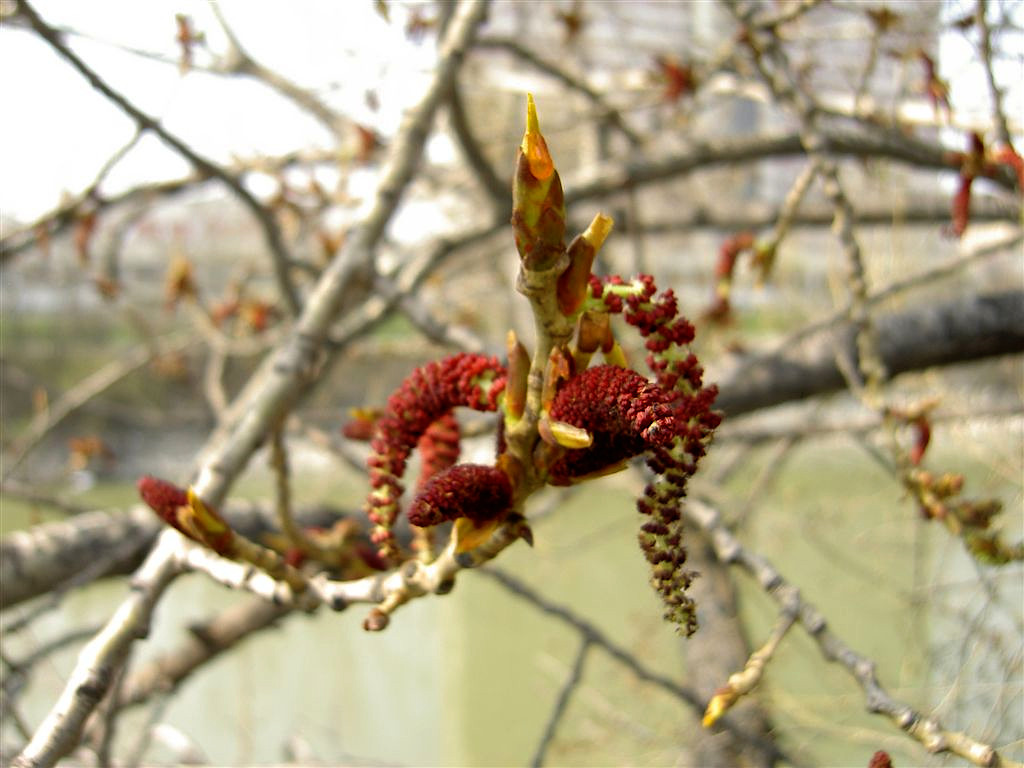Populus nigra L. - Salicaceae - black poplar, Schwarz-Pappel
Deciduous tree, up to 10-25m high, native to the river banks of Europe; leaves nearly cordate; young branches round across; flowers at catkins (up to 12cm long), produced in early spring before the leaves.
The sweet-cented exudate of fresh P.nigra buds is collected by bees as the basis of their genuine product propolis, which is subject of medical interest.
„26 different compounds have been investigated experimentally for their sensitizing capacity in guinea pigs. 19 of these occur in propolis as well as in poplar bud exudates, and 14 of them are also found in balsam of Peru. 4 caffeates and benzyl isoferulate were found to be strong Sensitizers. 7 compounds were moderate, and 13 compounds showed only weak sensitizing potency. Methyl cinnamate was negative. Patch tests in 11 propolis-sensitive patients once more revealed 3-methyl-2-butenyl caffeate and phenylethyl caffeate as the major sensitizers.“
[Propolis allergy (IV) Studies with further sensitizers from propolis and constituents common to propolis, poplar buds and balsam of Peru., Hausen, B.M., Evers, P., Stüwe, H.T., König, W.A., Wollenweber, E., Contact Dermatitis, 26(1), 1992, 34-44]
Phenylethyl caffeate, benzyl ferulate and benzyl-trans-4-coumarate are characteristic compounds found in propolis from various geographic origin.
[Chemical composition and antimicrobial activity of European propolis. Hegazi, Ahmed G., F. K. Abd El Hady, F. A. Abd Allah., Zeitschrift fur Naturforschung C 55.1/2, 2000, 70-75]
http://zfn.mpdl.mpg.de/xtf/data/Reihe_C/55/ZNC-2000-55c-0070.pdf
„Fractions in which 37 organic compounds were identified by means of GC-MS method were isolated using extraction of four propolis samples and bud exudate from Populus nigra. Six of them were identified in propolis for the first time. They are: 4-hydroxybutyric acid (4-hydroxybutanoic acid), 3-hydroxybutyric acid (3-hydroxybutanoic acid), phthalic acid, 4-hydroxyhydrocinnamic acid (phenyllactic acid), imidazole and phenetole. The main components of propolis fraction are acids: benzoic, cis- and trans-p-coumaric, ferulic, caffeic and cinnamic… Propolis ethanolic extracts consisted of 3.5-8.8% of dry residue and 2.9% bud exudate extract from Populus nigra.“
[GC-MS and HPLC analysis of phenolic acids extracted from propolis and from Populus nigra bud exudate. Maciejeicz, W., Daniewski, M., Dzido, T. H., Bal, K., Chemia analityczna, Vol.47(1), 2002, 21-30]
„Main volatile components of fresh leaf-buds of Populus nigra L. were sesquiterpene alcohols like β-eudesmol (19.1%) and α-eudesmol (9.6%) as well as sesquiterpenes like δ-cadinene (7.8%) and γ-selinene (7.6%) e.g. Severeal aliphatic and aromatic alcohols, aldehydes, ketones, acids and esters were identified like eugenol (1.1%) and methyleugenol (0.3%), benzyl alcohol (0.6%), 2-phenylethanol (1.1%), phenol (0.7%), cinnamyl alcohol (0.8%), benzaldehyde (0.2%), salicyl aldehyde (0.2%), 1,2-cyclohexanedione (2.6%), acetophenone (1.0%), octanoic acid (0.6%), dodecanoic acid (0.2%), and cinnamyl acetate (0.6%) e.g.
[Volatile compounds from leaf-buds of Populus nigra L.(Salicaceae). Jerković, Igor, and Josip Mastelić., Phytochemistry Vol.63(1), 2003, 109-113]

Thomé,O.W., Flora von Deutschland Österreich und der Schweiz, Tafeln, vol.2 t.177 (1885)
http://plantgenera.org/species.php?id_species=1267935

Populus nigra © Rolf Marschner (Wien 2005) www.botanische-spaziergaenge.at
